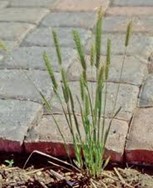Little Barley

Our question for the week is about controlling little barley in a lawn. Many people mistake little barley (Hordeum pusillum) for green foxtail because the foxtail and little barley seedheads are similar. However, little barley is a winter annual that comes up in late September - October and spends the winter as a small plant. It thrives in the cooler spring temperatures, forms seed heads, and dies out usually by July. Foxtail, on the other hand, is a summer annual that does well in hot weather. Also, foxtail will not produce seedheads until mid- to late-summer. The best control for little barley is a thick lawn mowed high enough that sunlight does not hit the soil. Little barley seed will not germinate in such conditions. Overseeding in the fall can thicken a tall fescue lawn and prevent a little barley infestation. However, if you do not plan to oversee it, preemergence herbicides can be used to help control this weed. Dimension (dithiopyr) is labeled for barley (Herodium spp.), which would include little barley and therefore can be used to give at least partial control. Dimension can be found in several homeowner products, including HiYield Turf & Ornamental Weed & Grass Stopper and Bonide Crabgrass and Weed Preventer. Other products may contain Dimension in combination with fertilizer or broadleaf weed killers. Because little barley is a winter annual germinating in the fall, apply the preemergence herbicide in early August and water it to activate. If overseeding, do not apply any preemergence herbicide as it will interfere with the germination of tall fescue. Unfortunately, we usually don’t notice it until it’s started to put up seed heads in the spring. At that point, your only control option is to pull or dig the plants up to prevent more seeds from being spread. Since it is a grass and not a broadleaf, there aren’t products labeled to control it in a lawn setting without hurting the rest of your grass.

Have questions? Contact our office where our Horticulture Extension Agent will assist you with questions.
Phone: (316) 321-9660
Email: callae@ksu.edu